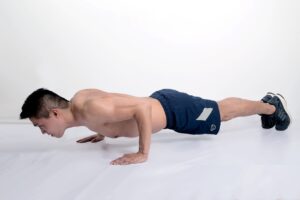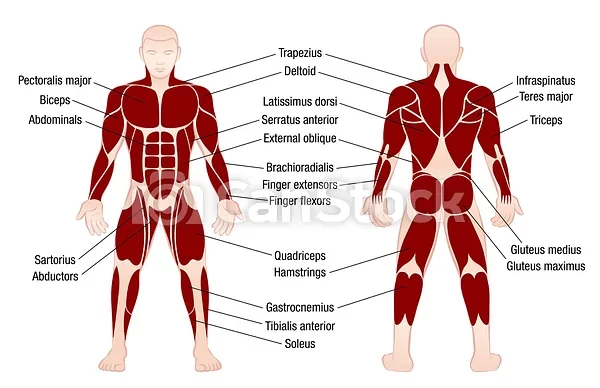Fitness Benefits of High Intensity Training
If you are serious about achieving maximum fitness benefit from your exercise program and want to do so using a very effective, highly efficient and safe method of training than you owe it to yourself to consider High Intensity Resistance Training. High Intensity Training (often referred to as HIT) is a scientific and highly researched style of training that will provide you with maximum results in minimal time.
I have long been amazed that so many people who work out regularly are uneducated about proper exercise and are unaware of how to best go about significantly increasing their fitness benefits. High Intensity Training is based on proven principles of exercise science, physiology, biomechanics, principles of logic and the laws of physics. The scientific research indicating the effectiveness of high intensity exercise is extensive and has been taking place since the 1970s. Professional Fitness Education on the topic of proper High Intensity Fitness Training can benefit anyone who exercises regularly.
High Intensity Training is not simply a term indicating that a person is exercising with a lot of effort. Rather it is an certain exercise method that follows a specific set of proven guidelines. HIT is not simply one set exercise routine but a style of training that follows those scientific guidelines to help individuals achieve a wide range of physical fitness benefits.
The benefits of a properly designed resistance training program is extensive. These benefits include increasing muscle strength, decreasing body fat levels, improved physical performance, building muscle mass, weight control, improved metabolic function, better bone density, improved insulin sensitivity, improved cognitive abilities and self-esteem, decreased low-density cholesterol and triglycerides and increased high-density lipoprotein cholesterol.
Fitness Benefits of High Intensity Training
High Intensity Training can play a very valuable role for people looking to control their weight and reduce bodyfat. Of course, eating a proper diet is very important, along with a lifestyle goal of reducing stress. Effectively reducing bodyfat can be enhanced by the utilization of stored glycogen, the release of fat burning hormones and the increase in the body’s metabolic rate, all are results of intense resistance exercise.
HIT is outstanding at building muscle tissue, increasing the metabolic rate to help reduce bodyfat and helping increase cardiovascular fitness. For several decades highly successful athletes and bodybuilders have achieved great results with High Intensity workouts.
To follow an effective program of high intensity exercise it is important to understand the importance of proper exercise form, high intensity effort, exercise duration, volume of work and the exercise recovery process. These topics and others will be explained here.
Proper Exercise Form
Proper exercise form for resistance exercise can best be described as using a slow and controlled speed of motion throughout the full range of movement. There should be no use of jerking the weight up or dropping the weight down and no use of momentum to help more the resistance. Using this as a guide for your exercise technique will significantly improve the effectiveness and safety of any strength training exercise. The laws of physics, specifically Newton’s Laws of Motion, will teach us that more muscle tension is created throughout the motion when using a slower motion speed. Faster movements should never be used as that makes the exercise less effective and increases the risk of injury. Unfortunately, many people who workout regularly fail to pay attention to how they are moving the weight and simply perform a certain number of repetitions regardless of how they accomplish those reps.
Improving Exercise Technique
Perhaps the best way to implement proper form is to focus on using a specific time span per repetition. It is human nature to make a physical task easier but for the perhaps of proper resistance strength training you should attempt to make the activity harder. A very effective method would be to lift the weight (often referred to as the positive or concentric phase) and 5 seconds to lower (the negative or eccentric phase). Using such a speed will do a lot to eliminate the use of momentum, increase the muscle tension and simply make the exercise harder to perform. One highly effective training method named Super Slow Training uses a 10 second lifting phase and 10 seconds to lower the weight. This form of training is a great way to safely force your muscles to work very hard to perform a strength training exercise.
Regardless of the exact speed of motion you use the important thing is to make sure you do not allow momentum to make the motion easier. Slower is better! As you continue to work thru an exercise each repetition will be harder than the previous one and you should focus on working hard until the exercise is complete. In addition, you should try to keep non-involved muscles relaxed and channel full effort into the muscles being trained. Avoid making faces and tensing neck and face muscles. Your body should be in a stable position when you start and remain there throughout the exercise.
Exercise Intensity
So, when exactly is a high intensity strength training exercise complete? Is it when you perform a certain number of reps? No, doing a certain number of reps is not really the goal. Your muscles cannot count. The muscles do know when all the available muscle fibers have been used to fatigue. This means you want to work to momentary muscle failure. To put it another way you are trying to do as many reps as possible, in good form of course, until you attempt and fail to complete a repetition. This is referred to as concentric muscle failure meaning no further lifting of the resistance is possible.
Training in this fashion is much harder than how a lot of trainees usually work but is the basis of high intensity training. Most gyms are full of individuals who perform low to moderate intensity exercise, with volume that is too high and poor technique.
Momentary Muscle Failure
Working to muscle failure is very difficult to do! But the good news is that when you train with this level of intensity you only need to perform one set per exercise! Many people have difficulty understanding and implementing the fact that one set to failure is the optimal training method. Traditional training usually consists of multiple sets and often multiple exercises for each muscle group. To accomplish this style of training you need to reduce the intensity level to accommodate the large volume of work. But with proper strength training the quality of exercise is more important than the quantity of exercise. There is a wealth of quality scientific research, going as far back as the 1970s, that indicates that one set of a properly conducted exercise is sufficient to get great fitness results! Exercise duration and Muscle Fiber Recruitment
Exercise duration and Muscle Fiber Recruitment
It is helpful to think of the fact that each of your major muscle groups have certain number of muscle fibers. The number of muscle fibers is determined genetically and cannot be increased with exercise. What can be increased with exercise is the number of active and available muscle fibers. Performing a high intensity strength training exercise to full fatigue will use all the available muscle fibers and this results in a stimulus for your body to adapt to that stress and recruit and make available additional muscle fibers in preparation for future bouts of exercise stress. This may be somewhat of a simplification of the strength gain process but for a practical understanding this is way to understand how your muscles increase in size, strength and performance.
For the purposes of a well-executed workout the point of momentary muscle failure should occur in the time span of approximately 1 to 2 minutes. A common repetition scheme is to perform about 8 to 12 repetitions, working to muscle failure and gradually increase the weight or resistance used when the upper rep range is accomplished. This progressive overload is vital to get your muscles to be doing more work over time. The exact number of repetitions are not nearly as important as working to muscle failure in good, strict form. Do not be too focused on the numbers. Never sacrifice good form for the sake of doing additional reps.
Some trainees focus on the exercise time and pay attention to the time it takes to reach muscle failure. The terms time under load (TUL) or time under tension (TUT) are sometimes used. For example, a person is taking 5 seconds to lift and 5 seconds to lower (10 seconds per rep) and completes 10 reps until muscle failure will have exercised for 100 seconds which is obviously in the time span of 1 to 2 minutes.
Exercise Volume for High Intensity Training
Along with the proper form of exercise and the intense level of effort, the amount of exercise needs to be appropriate for achieving top fitness results from your workouts. The number of exercises for a full body workout should generally be in the range of 5 to 10 different exercises targeting the large, major muscle groups of the upper and lower body. Because high intensity exercise requires a high level of effort and puts significant stress on the body, the total volume should be relatively low. It is a case of “more is not better”. Short, low volume but high effort workouts clearly provide the best results. Performing too much work puts excess stress on the body and reduces the body’s ability to recover and adapt properly to the exercise stress.
Along with the volume of exercise per workout the frequency of the workouts is vital. The reason for this is simple. Your body does NOT directly improve strength and fitness from exercise! Your body becomes stronger and more fit when you recover and adapt to exercise. After a dose of hard exercise your body will need to recover, adapt and then overcompensate. This recovery process is what produces fitness benefits. The process of recovery includes time, nutrition and sleep. If you are serious about your workouts in makes sense that you are serious about following a nutritious diet and develop good sleeping habits.
Exercise Frequency
The frequency of your workouts is vital to maximizing the your recovery process. Working out too often will fail to allow for full recovery and adaptation. It is very common for people to over-train and do too much exercise, thinking that more is better. Research shows that just 1 or 2 workouts per week provides the best results. Many advanced HIT trainees will work out just once per week. Even spacing your workouts a bit further apart or if you need to miss a regularly scheduled workout there seems to be no negative effect as long as the time between workouts is not so great as to allow for muscle atrophy.
The Key Elements of High Intensity Training
Here are the main points to keep in mind when structuring your High Intensity Training routine.
- Perform Full body Workouts once or twice per week on a regular basis
- Select Exercises that target the major muscle groups
- Execute One intense set in strict, proper slow and controlled form
- Each exercise is performed to momentary muscle failure, usually occurring within in a 1-to-2-minute time span
- Maintain Mental focus on proper exercise technique and performing with an intense level of effort
Exercise Selection and Sample High Intensity Training Workouts
Generally, a HIT workout will be a full body routine that exercises the major muscle groups of the skeletal muscular system. The major muscle groups usually targeted for resistance training include –
Quadriceps (front of upper leg)
Glutes (butt and hips)
Hamstrings (back of upper leg)
Calves (lower leg)
Pectoral (chest)
Trapezius (traps) (top of shoulders)
Latissimus dorsi (lats) – (large pulling muscle of the back)
Biceps (front of upper arms)
Triceps (back of upper arms)
Forearms (lower arm)
All the major muscles are important and significantly useful for many reasons. Do not think that they all need to be exercised in every single workout. In the outstanding book Body By Science authors McGuff and Little suggest a basic workout of just five exercises that will provide an outstanding overall full body training effect. This famous “Big Five Workout” includes –
Leg Press
Chest Press
Pulldown
Seated Row
Overhead Press
While this represents a short and simple workout, some people view The Big Five as rather basic. But as with all HIT training routines there are three important keys. These keys are always use proper form, work to muscle failure and allow for full recovery between workouts. Obviously, the equipment that is available to you dictates what exercises you can perform. Also, various biomechanical factors determine that some exercises are better than others. Below are just a few sample exercise routines for you to consider and perhaps adapt to your personal preferences.
Leg curl machine
Leg Press Machine
Calf raise exercise
Chest Press
Lat pulldown
Overhead press
Bicep curl
Triceps pushdown
——————————————————————-
Leg Press
Calf Raise
Abdominal crunches
Push Ups
Seated Row
Dumbbell Lateral Raise
Barbell Bicep Curls
Dumbbell Triceps Extension
————————————————————
Leg Press
Dips
Chin-ups
Overhead Dumbbell Press
Seated Row
Barbell Bicep Curl
Close Grip Push-ups
Abdominal crunches
Wrist Curls
You should consider many factors when you design your HIT workouts. The order of exercises is one of them. Many fitness experts suggest that the sequence should be to work the larger muscles before the smaller muscle groups. A sequence of working the legs followed by the torso muscles and then the arm exercises makes sense. Why is this? You want to work the larger and stronger muscles groups first. These require more energy. Also you do not want to fatigue a muscle that is going to be used as a supporting muscle later in the workout. Suppose you fully fatigue an arm muscle group such as the biceps first. Later you perform a lat pulldown exercise you may not be able to fully work the lats fully. Since the previously fatigued the biceps which are a supporting muscle for the pulldown you may not be able to work the lats as well.
——————————————————————————————————————————————-
David M. Waters received his Bachelor of Science Degree in Physical Education from the University of
Massachusetts at Amherst. His extensive professional experience in field of fitness includes work as a personal training
instructor, fitness director, competitive athlete, author and fitness facility manager. Having been involved with
exercise and fitness training since 1979, he has had the opportunity to help countless individuals as a physical
fitness educator, promoting exercise as a part of an active and healthy lifestyle.
David is the author of The Fitness Center Handbook which was originally written and published in 1988 and has been completely edited and updated for this current publication. Copyright registered with the US Library of Congress, 1988.
The information contained on this website is for educational purposes only. No attempt at prescribing an exercise
program has been made. The author shall not be held liable or responsible for any injury or damage resulting
from any individual’s participation in any exercise program. Individuals should consult with their physician prior to
undertaking an exercise program.
References-
https://pubmed.ncbi.nlm.nih.gov/22777332/
Body by Science: A Research Based Program for Strength Training, Body building, and Complete Fitness in 12 Minutes a Week -Published 2009, Dr Doug McGuff and John Little
High Intensity Training University
_______________________________________________________________________
The fitness information is provided for general informational and educational purposes only and is not a substitute for professional advice. Accordingly, before taking any actions based upon such information, we encourage you to consult with the appropriate professionals. We do not provide any kind of fitness advice. THE USE OR RELIANCE OF ANY INFORMATION CONTAINED ON THE SITE OR OUR MOBILE APPLICATION IS SOLELY AT YOUR OWN RISK.
________________________________________________________________________